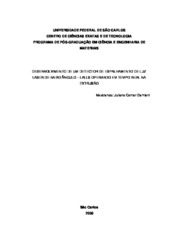| dc.contributor.author | Damiani, Juliano Conter | |
| dc.date.accessioned | 2016-06-02T19:12:13Z | |
| dc.date.available | 2011-10-20 | |
| dc.date.available | 2016-06-02T19:12:13Z | |
| dc.date.issued | 2005-12-08 | |
| dc.identifier.citation | DAMIANI, Juliano Conter. Development of a low angle laser light scattering lalls working on-line with extrusion. 2005. 122 f. Dissertação (Mestrado em Ciências Exatas e da Terra) - Universidade Federal de São Carlos, São Carlos, 2005. | por |
| dc.identifier.uri | https://repositorio.ufscar.br/handle/ufscar/845 | |
| dc.description.abstract | In the present work a prototype of a low angle laser light scattering was developed and installed in an extruder in order to operate in real time. The equipment was built by the research group of which the author is member, and low cost pieces were used when it was permitted. It was consisted of a laser beam which passes through the molten flow and a detector system formed by 64 photocells radially disposed to quantify the transmitted scattered beam. The molten flow used in this work was consisted of a PP matrix with a dispersed phase constituted of polymer (PA6, PS) or ceramic powder (TiO2, Al2O3). The resulting LALLS graphics showed dependence with second phase type. The signal from the detector is much stronger when ceramic powder was used. A dependence with the concentration was observed as well, as this factor affects the number of particles directly. The interpretation of the results was based on the considerations of Mie s theory, which correlates refraction indexes differences, particle size and concentration of the dispersed phase with the occurrence of single and multiple scattering. The measurements were all taken in the transient state, where the second phase is added in the polymer flow in the form of a pulse, and its behaviour is quantified in the extruder exit by the LALLS detector. Even when operating under severe conditions, like extrusion pressures (around 11 MPa) and temperatures (240°C or above), the detector showed enough sensibility to quantify the scattered light generated even by the blends used in this work. | eng |
| dc.description.sponsorship | Universidade Federal de Sao Carlos | |
| dc.format | application/pdf | por |
| dc.language | por | por |
| dc.publisher | Universidade Federal de São Carlos | por |
| dc.rights | Acesso Aberto | por |
| dc.subject | Polímeros | por |
| dc.subject | Difração | por |
| dc.subject | Processamento de polímeros | por |
| dc.subject | Blendas poliméricas | por |
| dc.subject | Células fotoelétricas | por |
| dc.title | Desenvolvimento de um detector de espalhamento de luz
LASER de baixo ângulo LALLS operando em tempo real na extrusão | por |
| dc.title.alternative | Development of a low angle laser light scattering lalls working on-line with extrusion | eng |
| dc.type | Dissertação | por |
| dc.contributor.advisor1 | Canevarolo Júnior, Sebastião Vicente | |
| dc.contributor.advisor1Lattes | http://genos.cnpq.br:12010/dwlattes/owa/prc_imp_cv_int?f_cod=K4781975Z6 | por |
| dc.description.resumo | Nesta dissertação desenvolveu-se um protótipo de detector de espalhamento de LASER de baixo ângulo instalado na extrusora para operação em tempo real. O equipamento foi construído inteiramente pelo grupo de pesquisa do qual o autor faz parte privilegiando-se o baixo custo dos componentes. Constitui de um feixe de laser atravessando um fluxo de polímero fundido e um sistema detector formado por 64 fotocélulas posicionadas radialmente, para a quantificação da intensidade do feixe espalhado transmitido. O fluxo fundido usado constituiu-se por uma matriz de PP com uma segunda fase dispersa do tipo polimérica (PA6, PS) ou uma carga cerâmica (TiO2 e Al2O3). As curvas de espalhamento de LASER mostraram-se dependentes do tipo da segunda fase sendo que as medidas com fase dispersa cerâmica mostram sinal muito mais intenso. Também tem-se uma forte dependência da concentração da segunda fase pois esta afeta diretamente o número de partículas. A interpretação dos resultados de espalhamento se baseou nas considerações da teoria de Mie que correlacionam diferença de índice de refração, concentração, tamanho de partícula com a ocorrência do espalhamento e particularmente o espalhamento múltiplo. As medidas foram feitas todas em regime transiente, onde a segunda fase é adicionada no fluxo fundido na forma de um pulso, sendo seu comportamento quantificado pelo detector na saída da extrusora em tempo real. O detector mesmo operando em condições severas nas faixas de temperatura e pressão típicas da extrusão, ou seja, da ordem de 11 MPa e 240°C mostrou ser robusto e ter sensibilidade suficiente para quantificar o espalhamento das blendas poliméricas modelos utilizadas | por |
| dc.publisher.country | BR | por |
| dc.publisher.initials | UFSCar | por |
| dc.publisher.program | Programa de Pós-Graduação em Ciência e Engenharia de Materiais - PPGCEM | por |
| dc.subject.cnpq | ENGENHARIAS::ENGENHARIA DE MATERIAIS E METALURGICA::MATERIAIS NAO METALICOS::POLIMEROS, APLICACOES | por |
| dc.contributor.authorlattes | http://lattes.cnpq.br/2469541507195811 | por |
